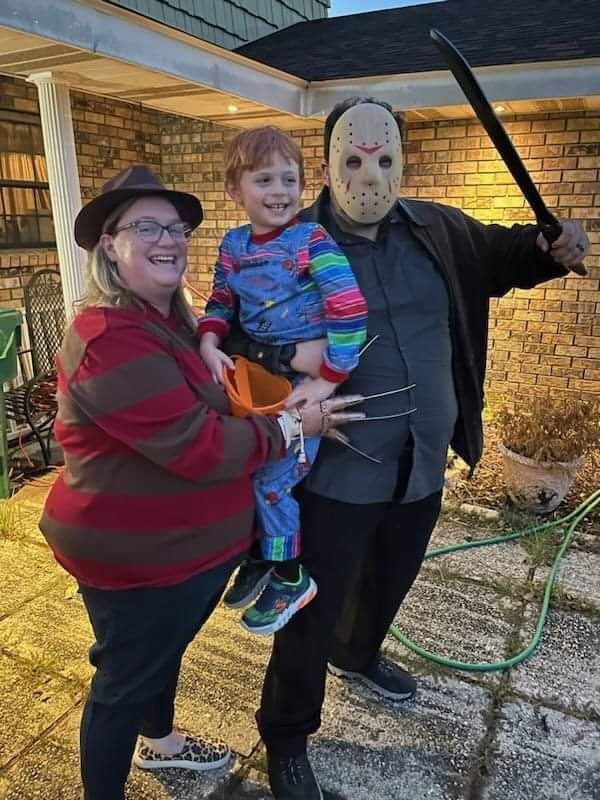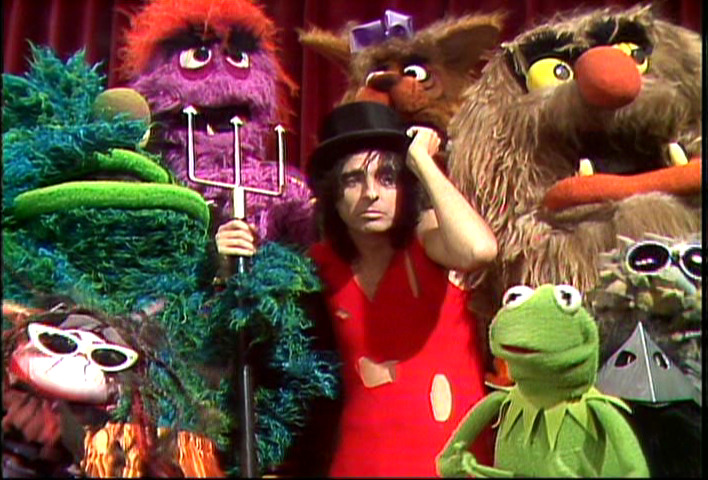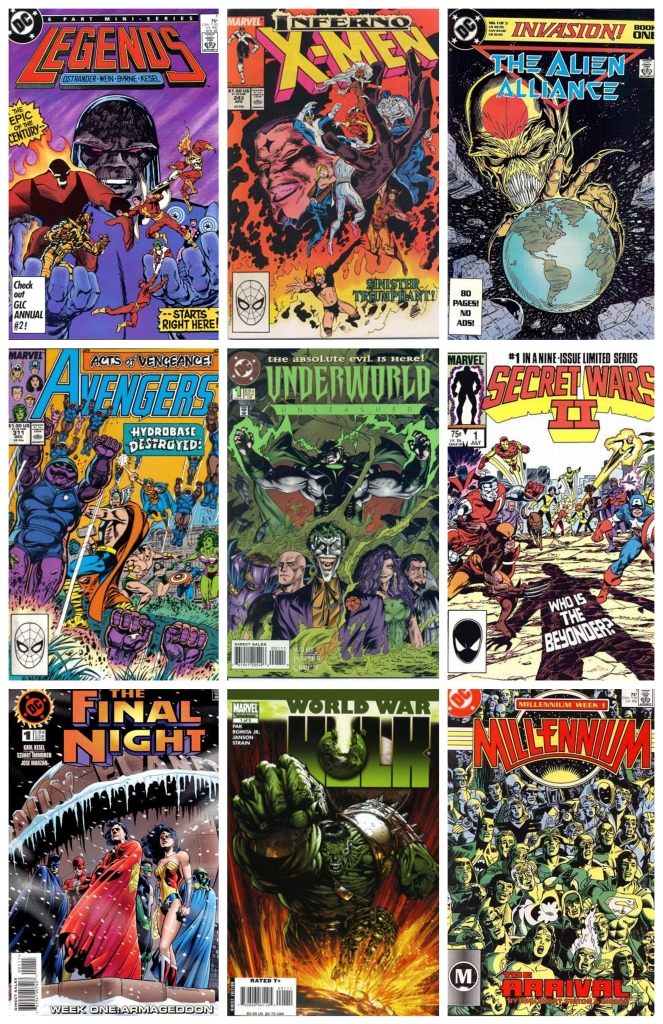Scientists have determined scientifically, using specific scientific methods and scientific instruments, that August is longer than all other months combined. School is back in session, it’s 127 degrees outside, and frankly, nobody is having a good time. So once this teacher’s summer break ends and he goes back to work, I am fully prepared to embrace the next thing on the horizon that I have to look forward to: Halloween.
Some people will say that it’s too soon to get excited about Halloween. Some people will say that summer isn’t over yet. Some people will complain about holidays creeping earlier and earlier in the year. To these people, I have one word: “Boo.” I mean, if you’re the sort who actually enjoys summer (like some kind of a weirdo), okay. Enjoy it as long as you can, and I do not begrudge you. But for everyone else, you’re just gatekeeping, and gatekeeping is dumb. There aren’t enough good things in the world for us to put up arbitrary barriers designating when and how something is allowed to be enjoyed, and if you want to put up your Halloween decorations tomorrow, there is no reason not to. (Unless you’ve got a Home Owner’s Association that forbids it, of course, but HOAs are basically just organized gatekeeping, and gatekeeping is dumb.)

Now don’t misunderstand me – I’m not putting on a costume and watching Garfield’s Halloween Adventure yet. SOME things in my household DO wait for October. But this is the time of year where I start allowing bonus creepy content into my viewing habits: 80s slasher films, ghost stories, monster movies…beginning in August, the percentage of my viewing time occupied by these types of things slowly begins to increase until, by October 1st, it’s basically All Creepy All the Time. The wonderful thing about Halloween in this regard is that the gatekeepers tend to step back a little bit. It’s not like Christmas, where people will arm themselves with gingerbread swords and go to battle over what does and does not constitute a Christmas movie (even though the criteria are pretty simple, as I outlined a few years ago). For Spooky Season, there is no requirement that a movie or TV show be set on or around Halloween – it merely has to have a modicum of creepy content and people will accept it as seasonally appropriate.
And that’s a good thing, too, because there actually aren’t a ton of great movies set on Halloween itself. Sure, you’ve got your John Carpenter’s Halloween and your Hocus Pocus and a few others, but for every one of those you’ve got a TERRIBLE movie set at Halloween, such as Halloween Ends and Hocus Pocus 2. If you limit yourself to only viewing movies set in October during your viewing, even if you wait until October 1st to begin, you’ll run out of quality content long before the big day. And thus we, the Halloween Lovers of America (or HLA, for short) have agreed to accept virtually anything with monsters, ghosts, goblins, or gore as acceptable viewing during the Spooky Season.

In fact, many of the most iconic Halloween costumes come from stories that have nothing to do with Halloween itself. Take the Ghostbusters, for example. It seems almost unthinkable to go through the Halloween season without seeing somebody strapping on a Proton Pack or shouting “I ain’t ‘fraid of no ghosts,” but none of the Ghostbusters movies take place anywhere near Halloween. Ghostbusters II, in fact, reaches its climax on New Year’s Eve! (Yes, before you ask, it does count as a New Year’s Eve movie.) But because the franchise itself is centered around ghosts and the people who – y’know – bust them, they have become integral figures in the Halloween canon.
The same goes for most movie monsters. The Universal Monsters are my favorite. I love the movies, I love the style, I love the decor. But I can’t think of a single Universal Monster film that actually takes place on Halloween. The closest thing I can recall is the masquerade ball in Abbott and Costello meet Frankenstein, and even THAT isn’t specifically noted as being a Halloween party. (I’m sure somebody will inform me of any exceptions that have escaped my mind.) Despite this, the most common versions of Dracula and the Frankenstein monster you’ll see are the ones based on Boris Karloff and Bela Lugosi, and they’re everywhere. Likewise, the 80s slasher icons are similarly ubiquitous at this time of year, but of them only Michael Myers is Halloween-specific. That doesn’t stop anybody from dressing up like Jason Voorhees or Freddy Krueger, though, nor should it. Last year my wife and I dressed as Freddy and Jason, respectively, to have a little slasher family to go with our son, who chose a Chucky costume. Nobody complained, although I’m not sure my grandmother realized what, exactly, Eddie was supposed to be when she called him adorable.

So when it comes to choosing Halloweenish movies, all of those are perfectly acceptable fare, but why stop there? What about Kaiju? Giant monsters like Godzilla, Gamera, and King Kong are not particularly Halloweenish. Am I allowed to watch those movies during this time frame? I mean…there’s nothing that stops me from watching them any day of the year (makes for a weird Easter, honestly), but when I’m compiling my requisite Letterboxd list of annual seasonal viewing, do I include them? They are monsters, after all. And we’ve all seen a guy show up at a party wearing a gorilla costume. I say that it counts. And for that matter, so does any given episode of a spooky TV show, whether you’re talking about macabre comedies (macabredies? Can I invent that word?) like The Addams Family or The Munsters or whether it’s full-on horror like Tales From the Crypt or Creepshow. It basically all boils back down to the gatekeeping thing. Nobody else is allowed to tell you what can put you in the Halloween mood or when it’s acceptable, or for that matter, no one can say you have to be in the mood if you don’t want to either. Do what makes you happy.
What makes me happy, I should point out, is the Spirit Halloween store. Every year I start itching around mid-June, looking at the abandoned storefronts in my area and wondering which ones Spirit is going to swoop in and absorb into their web this time around. 2023 may be the most abundant year yet for me. For the second year in a row they’ve set up shop in a strip that’s often on my way home from work (it depends on whether or not it’s my turn to pick up my son from school). But there’s a second one that my wife has to drive past on her way to and from work – and as if that weren’t enough, the third Spirit Halloween in our area is set up in the vacant Bed Bath and Beyond immediately next to my wife’s place of employment. It’s almost as if the Spirits of Spirit knew it had been a rough year and wanted to do just a little something to make us happy.

If Spirit was open year-round I would be thrilled, honestly. Granted, there are certain things that wouldn’t be year-round sellers (nobody really needs a screaming pumpkin in February), but I also live near the city of New Orleans, and there’s much more of a call for costume pieces and decorations here 365 days a year than there is in, for example, Bloomington, Indiana. I’ve also often petitioned them to pivot when November begins and turn into “The Spirit of Christmas,” which would at least give me an additional two months of seasonal retail therapy, but so far they’re just ignoring my Tweets.
Regardless, going to Spirit is very much a thing in my family. We’ve already visited all three of the stores I mentioned before, with a fourth one not too much further away, and we’ll probably stop in at all of them again before the season is over. We told my son, who is almost six, that we’re not getting his Halloween costume until we’re a little closer to October. Six-year-olds have a tendency to grow like they’ve been injected with Pym Particles and also to change their minds 197 times a day, so it’s a bit early for us to lock him into a specific size or character. But that said, Eddie loves visiting the Spirit store. We were worried when he was younger that it may be too scary or intimidating for him, but he is his mother’s child. He loves to activate the assorted animatronics on display and make them shriek and pop up, and it’s delightful to watch because he always gets scared for approximately a half a second before giggling like mad and rushing to step on the button again…which, frankly, is the perfect reaction. This is exactly what the people who design those things WANT you to do, and unlike an adult or teenager who feels the need to pretend it doesn’t affect them, he’s still young and innocent enough to let his emotions run the way they should.
He likes the decorations and costumes as well – this year he’s asking to try on the masks, which in the past he would never do. He asks specifically to “be” the character on the label, which becomes painfully adorable as he reads the packaging and says things like, “Can I be Spidah-Man? Can I be Fwankenstein? Can I be Da Purge?” He even gave us, completely unprompted, an “It’s-a me, Mawio!” I know that, as his father, I am biased, but that moment deserves to win the Nobel Prize in Cute.
My wife and I are both nerds, and although our spheres of nerdery are not a perfect venn diagram, Halloween is a huge section of overlap. The fact that my son has come to embrace that section as well thrills me to no end. So if you’re here to tell me that August 25th is too early to sit down with him and watch Mad Monster Party and episodes of The Real Ghostbusters or to put on Renfield or Evil Dead Rises after he’s gone to sleep, I’ll tell you that you’re flat-out wrong and that you need some full-size candy bars in your life.
Now I know some readers turned away from this week’s column as soon as they realized I was talking about Halloween so early, so I know they’re not reading this. If you made it this far, I assume you love and are ready for the Spooky Season as much as I am. So to you, my friends, my fellow Cryptkeepers and Svengooligans, I say this: have a great couple of months, binge yourself silly on creepy content, and let your freak flag – quite literally, in many cases – fly high and proud.
I’m calling it. Our time starts NOW.
Blake M. Petit is a writer, teacher, and dad from Ama, Louisiana. His current writing project is the superhero adventure series Other People’s Heroes: Little Stars, a new episode of which is available every Wednesday on Amazon’s Kindle Vella platform. He really hopes his son sticks with his current plan of being Mario for Halloween and doesn’t switch to Spider-Man, because he likes to dress up with the kid and he’d make a better Luigi than a Mary Jane.


















